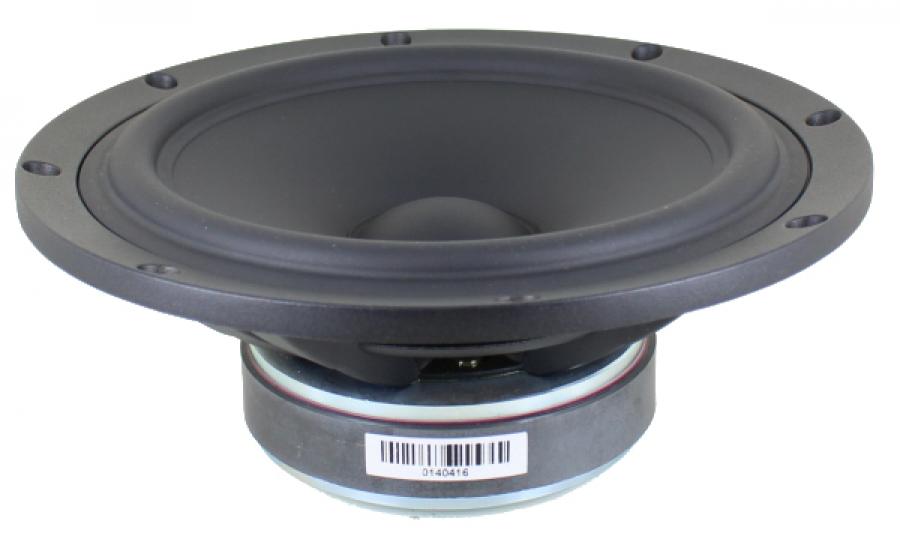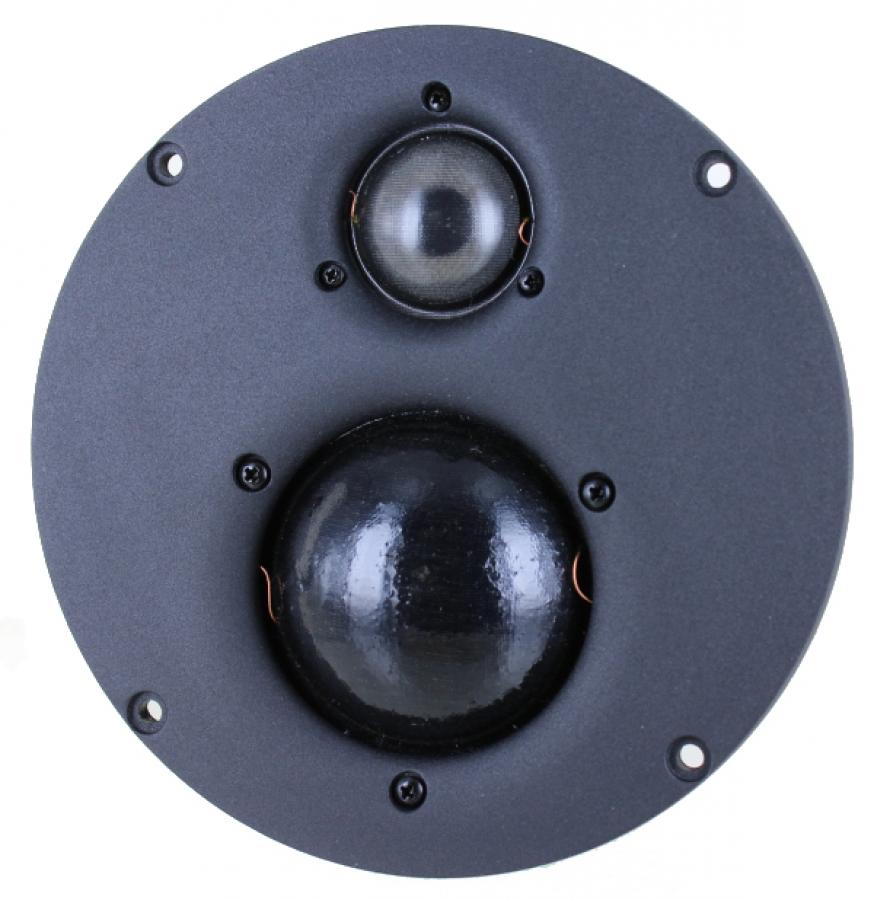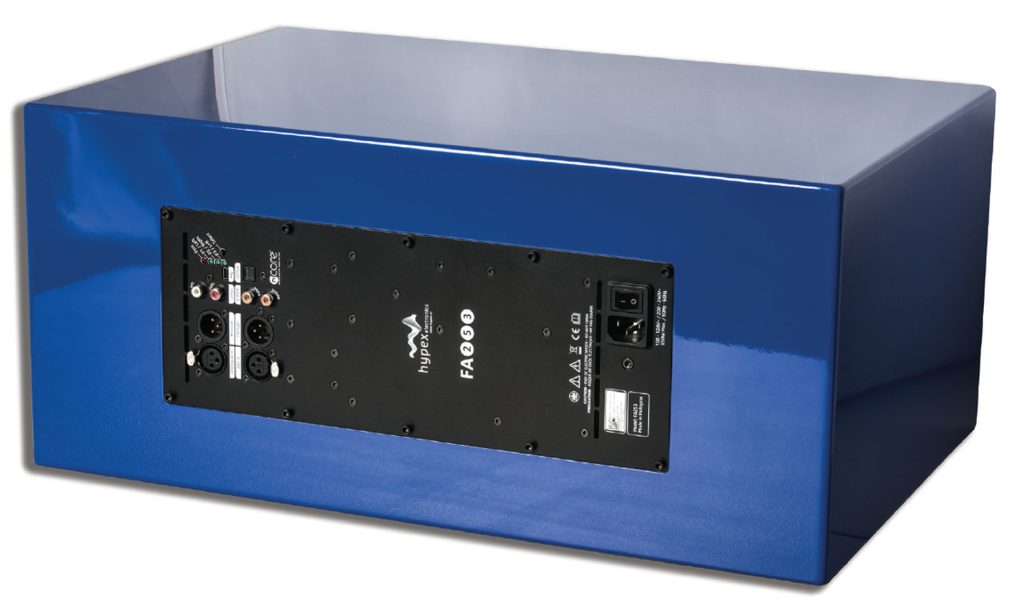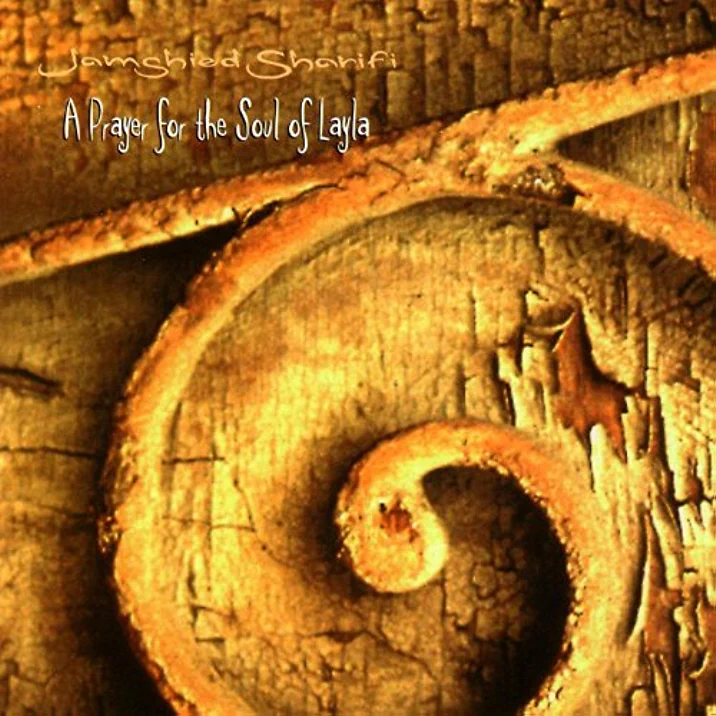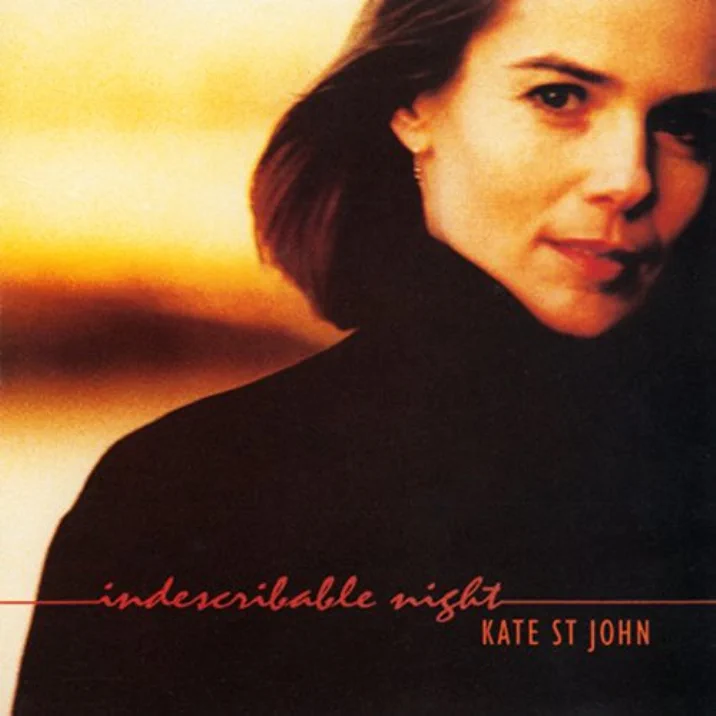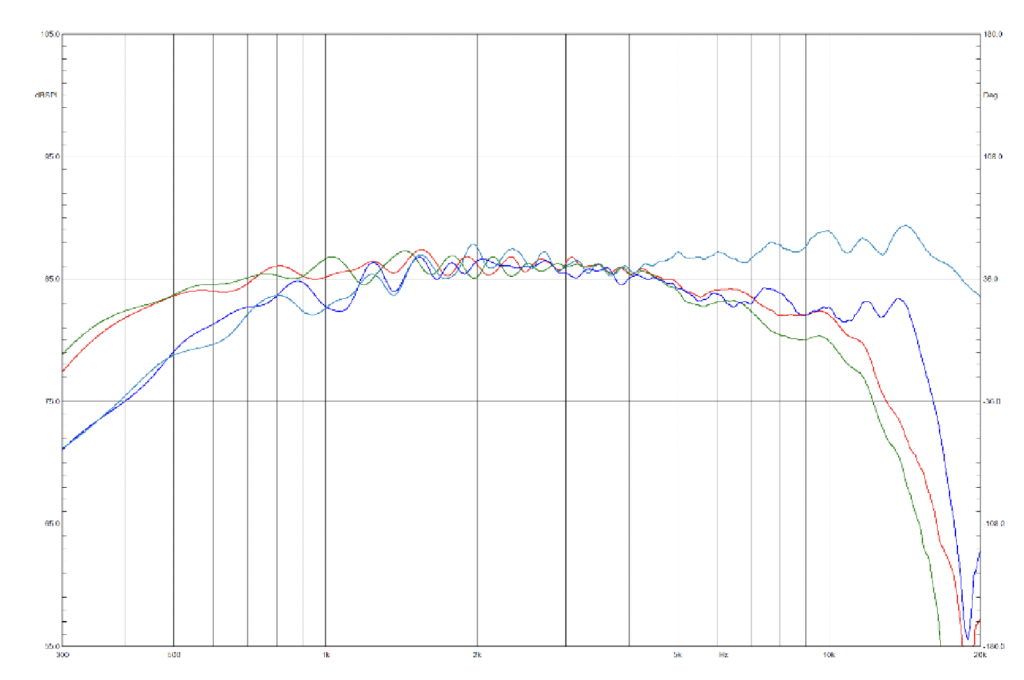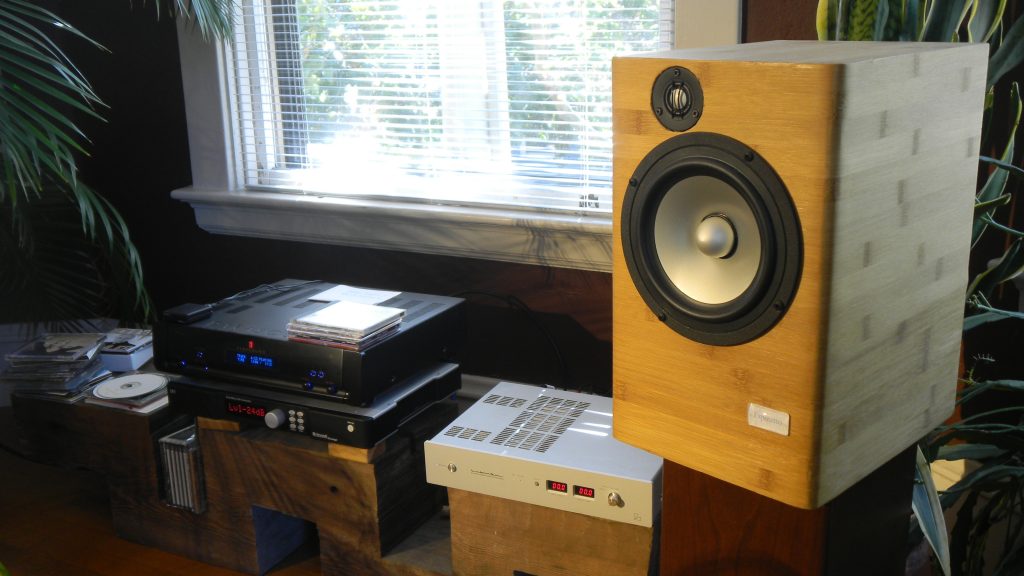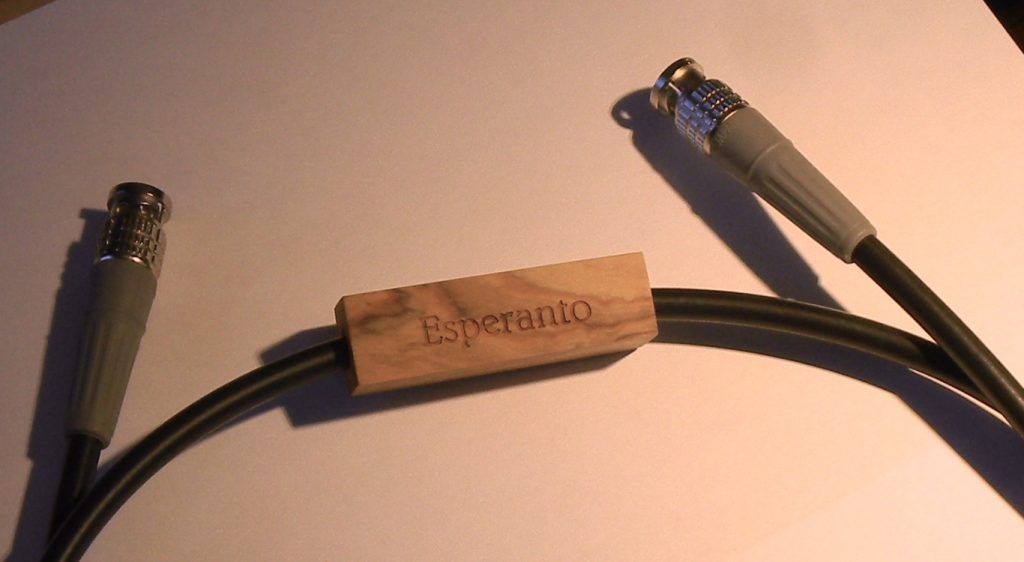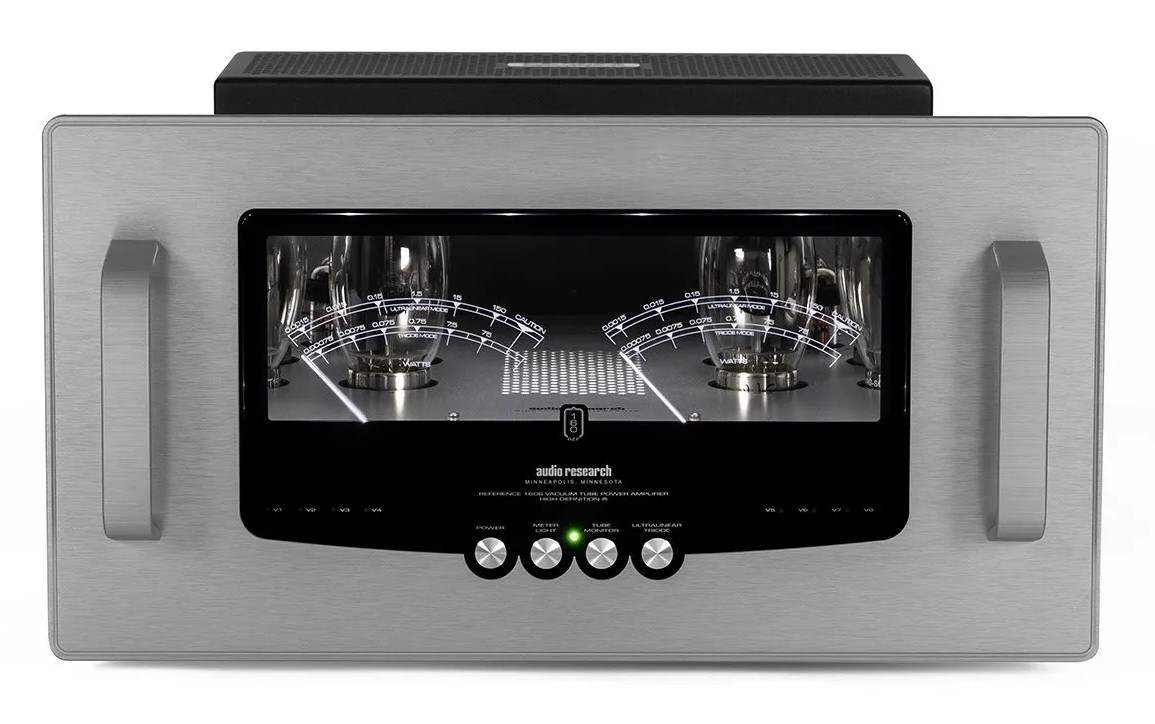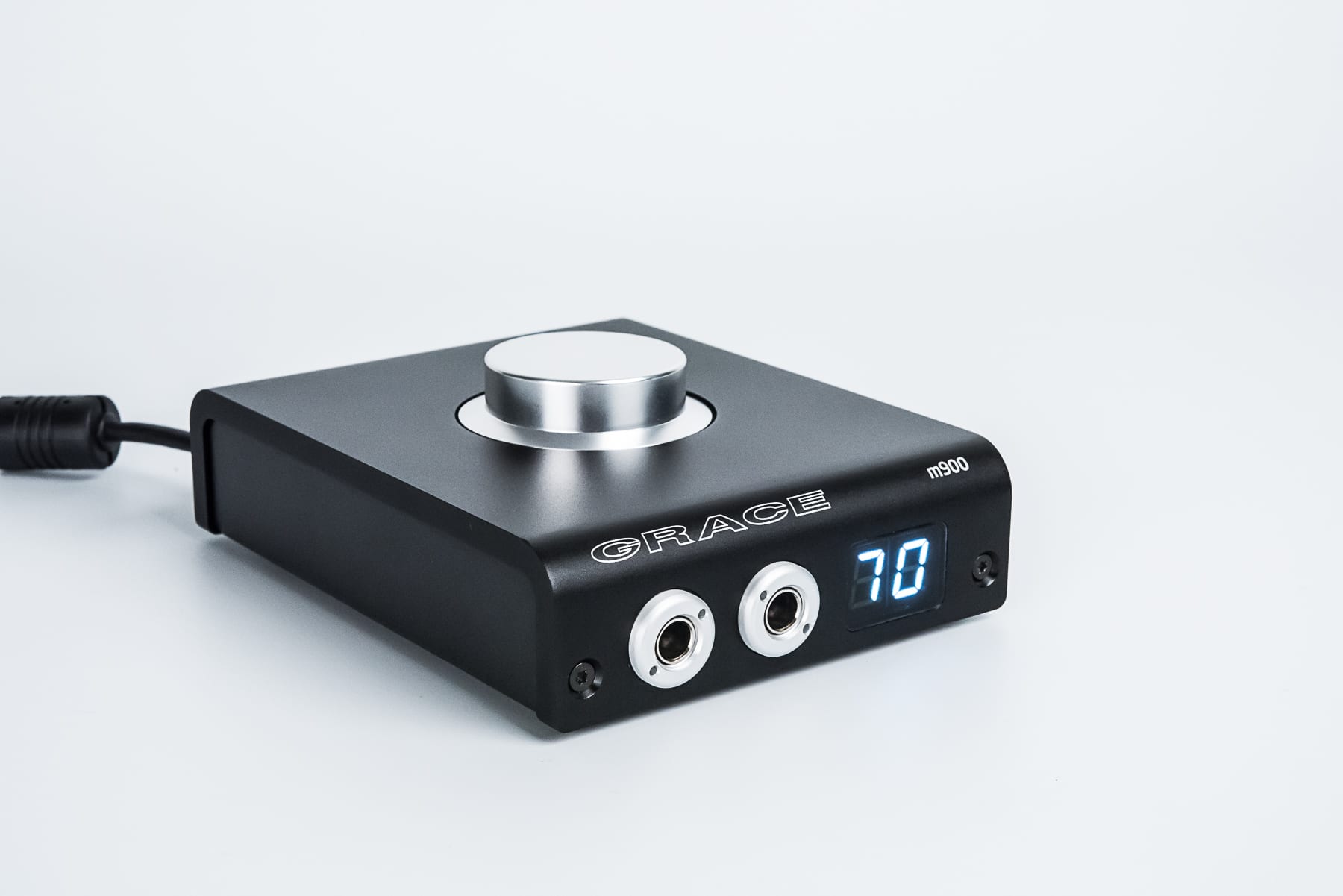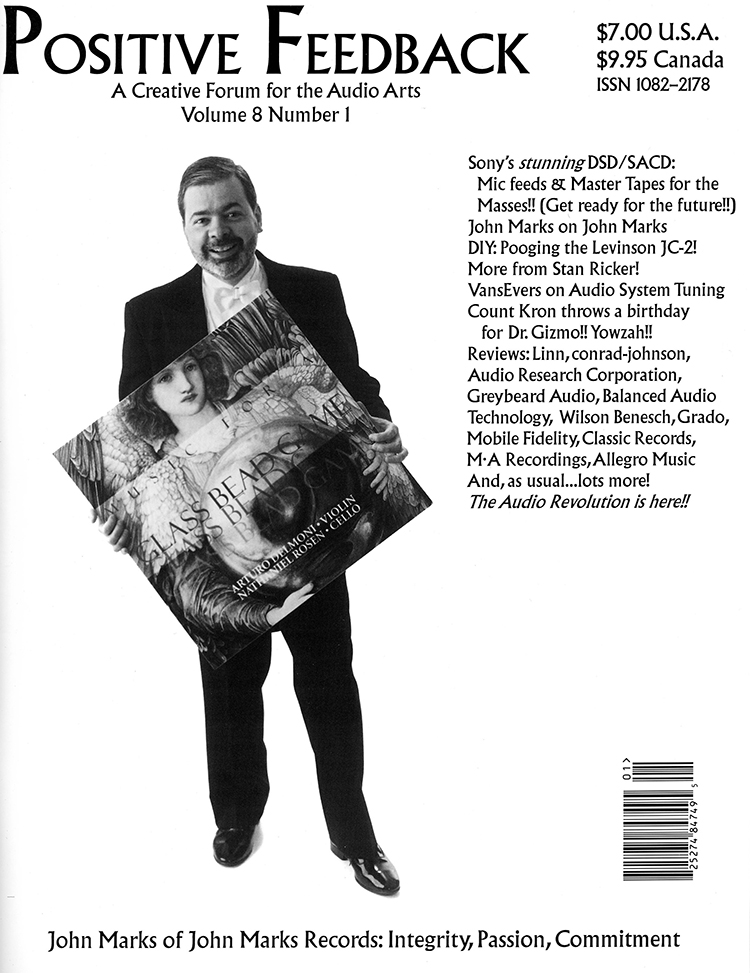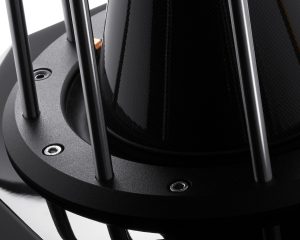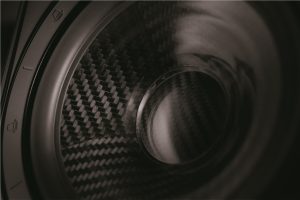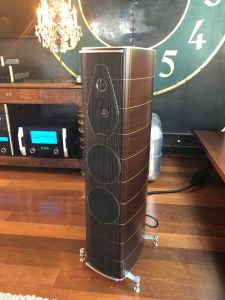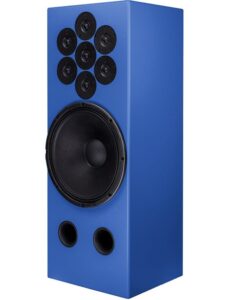Every now and then—but really, not all that frequently—a product appears that really "shakes the chessboard" in terms of performance, value for money, or both. The Monitor 9 from Solen Electronique is one such product. Solen is a Montreal-based Canadian company with manufacturing facilities in Canada and France. Its overall performance is top-tier, and its comparative value for money is simply amazing.
Solen's Monitor 9 is a ported-enclosure three-way studio monitor with a robust (nominal) 9-inch woofer—from Indonesia's Sinar Baja Acoustics/SB Acoustics. The cabinet measures 22.5 x 10 x 15 inches. I estimate its internal volume to be 35 liters. Therefore, its size is smaller than the classic 24 x 12 x 12 "BBC Two-Cubic-Foot" studio monitor—which is also known as the Bob Marley monitor, because Marley's music blew up the smaller BBC monitors. Therefore, the BBC had to build a bigger one. The Monitor 9's construction from 1-inch MDF results in each loudspeaker's weighing circa 44 pounds. These are large, heavy loudspeakers, with very inert cabinets.
The passive version (9) has a conventional, analog-parts crossover. The active version (9A) is powered by Hypex's digital/DSP plate amp the FA253, which has three channels of amplification: 250 watts each for the woofer and midrange, and 100 watts for the tweeter. FYI, those Hypex modules retail for about $650 each. (Solen does add capacitors to the tweeter and midrange sections of the active version, in order to protect the drivers.)
To plunge right to the financial bottom line: The Monitor 9 passive version is priced at CAD$3499/pr. The US dollar is higher than the Loonie, so the US price is $2613/pr. The active version is priced at CAD$5249/pr., so the US price is $3324/pr. The optional upgrade to any Automotive finish you can provide a paint code for is CAD$500/pr., which at the time I was writing this was USD$374.
If you browse the B&H Photo or Sweetwater Sound pro-audio websites, you can find powered loudspeakers with "professional aspirations," as well as powered loudspeakers from household-name companies—such as ATC—with 9-inch woofers, at prices ranging from under $1000 the pair, up to $17,490 the pair.
To provide one benchmark, ATC's three-way active monitor with a 6.5-inch woofer is street-priced at $8990/pr. Solen's active monitor with a 9-inch woofer is less than half that amount. There are 9-inch active monitors priced lower than Solen's 9A, but they all seem to have smaller cabinets and therefore, bass extension that does not go as low—Solen claims 25Hz.
One well might ask how Solen manages to pull off the feat of under-pricing by more than 50%. The answers include that Solen is a distributor for all the parts it includes in both versions of the Monitor 9. Furthermore, Solen is a well-known maker of passive components such as coils, capacitors, and resistors.
Importantly, Solen, as the loudspeaker designer and manufacturer, sells direct to consumers, so there is no retailer/dealer markup. Finally, Solen does not advertise in the usual high-end-audio consumer magazines. I have only seen Solen's advertisements in loudspeaker-industry trade magazines.
To make another comparison: The passive version of Solen's Monitor 9 is priced at USD$2613/pr. There is no shortage of "BBC LS3/5A Legacy Shoebox Monitors" priced within a few hundred dollars of that price point; while some deluxe examples run much higher, up to around $3500 the pair.
The BBC Legacy Shoebox Monitor usually has a 5.25-inch woofer, which usually means a frontal area/pushing area (Sd, in the Thiele-Small Parameters) of circa 75 cm2. However, the SB Acoustics 9-inch woofer in Solen's Monitor 9 has a pushing area of 255 cm2. That's a 340% difference. The difference in bass extension is circa 75Hz vs. circa 25Hz. That's a full octave, plus the musical interval of a fourth.
The Monitor 9's woofer is from SB Acoustics, which has established itself as one of the most important OEM loudspeaker driver manufacturers—several prestige US loudspeaker companies use SBA drivers. The Monitor 9's woofer's basket has an outside diameter of 9.25 inches; the woofer cone itself is 8 inches in diameter.
I note that the SBA woofer is screwed in with "Square Head" Robertson-head wood screws. Perhaps that was so that the Customs inspectors would nod and say, "Yep. Robertson screws. 'Made in Canada,' fer sure!"
For the midrange and tweeter, Solen chose a modular (modular, but not coaxial) approach from Israeli manufacturer Morel. Morel's "TweeMid" module combines a 2-inch fabric-dome midrange and a 1-inch fabric-dome tweeter on a common round faceplate circa 5 inches in diameter.
This modular arrangement confers two advantages. First, it allows for a very close spacing of the acoustic centers of the two drivers, which means that with a properly-chosen crossover frequency, the two units will approximate a point source.
Secondly, the round mounting plate makes it possible to position the loudspeaker cabinet horizontally rather than vertically, rotating the mounting plate 90 degrees so that the tweeter remains above the woofer. While most home audiophiles will never use this feature, it is designed for professional use, when the monitors will be placed on or behind a large mixing console's meter bridge.
Decisions, Decisions
My review pair was a pair of the active monitors, in a faultless Royal Blue (or Cobalt) automotive finish. Unpacking was a bit more work than it should have been, owing to the packing protection being Styrofoam peanuts; I have suggested that Solen up their game in that respect. Styrofoam foundation insulation boards should be just the ticket.
The first thing you have to know is that the Hypex module powering the Monitor 9A is intended for professional use. Therefore, its default mode is an Energy-Saving regimen wherein the plate amp powers down to "Standby" if there has been no input signal for some minutes.
In my experience, there was a "wake-up latency" which usually caused me to re-start a track so I could hear the very beginning. Solen advises me that if one downloads the HFD (Hypex Filter Design) programming software—and, you get past the learning curve—you can opt out of the Energy Saving.
That said, I would not leave the amps on all the time—they do run warm. There is an automatic fan-based cooling system for the plate amp, but I never heard it operate. In addition, there is a Soft Clipping option, but, by default, that is disabled.
BTW, were one of a technical bent, and if one were to buy the 9A active monitors and learn the programming software, one could in theory re-do the crossover curves, which might be the deal-maker for some potential buyers. The factory settings are: the woofer-to-midrange crossover point is 800Hz and the midrange-to-tweeter crossover point is 3800Hz, with 12dB/octave slopes, and some DSP employed to flatten the response curves.
The next thing you will probably want to know is that although the Hypex plate amps do have USB jacks on their rear panels, the USB port is only for software upgrades; it is not an audio input. Bummer.
Therefore, to feed the active Monitor 9A a digital signal it can recognize, you have to feed it a S/PDIF or AES digital signal, on RCA or TOSLINK jacks for S/PDIF, and XLR for AES. The digital inputs have pass-through jacks, and the control panel of the plate amp enables you to assign a loudspeaker as Left or Right when there is a digital input. You can also assign a speaker to play "L + R" from a digital signal, but I can't imagine a home-audio enthusiast doing that.
The Monitor 9A also has analog inputs—and analog pass-throughs; again, I think they are irrelevant for home use—single-ended on RCA, and balanced on XLRs. Solen tells me that the Hypex Fusion FA253 is fully balanced, end-to-end.
Please be aware that the active version's connections to the drivers are only from the plate amp, and therefore, the analog signal you feed the Hypex FA253 undergoes an analog-to-digital conversion stage. To restate, the analog inputs of the Monitor 9A do not connect to analog passive crossovers. Therefore, the analog inputs should only be line level, and not amplifier level. The FA253's on-board ADC (AK5554) operates at 32-bits, with a sampling frequency of 192kHz (96kHz for optical input).
Morel's Corporate Ancestral DNA
Israeli loudspeaker company Morel—short for Mordechai Electronics—has a fascinating "Corporate Ancestral DNA." The original company was "RMS"—an audio-engineering pun, perhaps?— a partnership among Gerhard Richter, Meir Mordechai, and Ejvind Skaaning, formed in Israel in 1979. Perhaps the name Skaaning rings a bell?
In 1968, Mr. Skaaning was the subcontractor who built the woofer for the famous Dynaco A25 loudspeaker. Based on that success, in 1970 Scanspeak was founded, with Mr. Skaaning in charge of transducer development as well as operations in general. At some point, Ortofon acquired Scanspeak, but then The Children of Darkness—by which I mean, Harman International—acquired Ortofon, and then Harman decided to divest itself of Scanspeak.
Which perhaps is why Mr. Skaaning was seeking to widen his horizons. Mr. Richter was a successful distributor of loudspeakers in Germany, and Mr. Mordechai was an ambitious engineer who wanted to build world-class drivers.
That Mr. Mordechai achieved his goal is evidenced by the fact that Morel midranges are part of the driver complement in mastering engineer Bob Ludwig's Egglestonworks "Ivy" monitoring loudspeakers.
However, perhaps a suburb of Tel Aviv in 1979 was not the optimal siting choice, especially because Mr. Skaaning was heavily invested in Lebanon (as well as having a Lebanese fiancée). When civil war broke out Lebanon, Mr. Skaaning cashed out and moved back to Europe, partnering with Mr. Richter—and later Wilfried Ehrenholz—to start a new audio company called… Dynaudio.
So, there you have it! Dynaudio, Scanspeak, and Morel have common Corporate Ancestral DNA! Mr. Skaaning's design legacy also lives on in Danish ultra-high-end driver manufacturer Audio Technology.
These days, Morel operates in three different business areas: finished loudspeakers; raw drivers for loudspeakers; and raw drivers for non-traditional uses. One example of the last category is the fact that Morel supplies the drivers for the nine-channel factory autosound system for the Italian Pagani supercar. Morel also makes specialty drivers for the private-aircraft and luxury-yacht aftermarket-upgrade industries.
But Morel's core business is raw drivers—not only subwoofers, woofers, midranges, and tweeters, but also coaxial drivers, and shallow-profile drivers and shallow-profile coaxial drivers. Shallow-profile, because there isn't much back space when you are installing a loudspeaker driver in a private jet.
Listening
The sound from Solen's Monitor 9A is crisp, clear, clean, punchy, and detailed. I credit the tweeter-midrange module for the remarkably stable imaging and soundstaging. But I think that the first thing that calls attention to itself is the powerful and well-articulated bass. Although the Monitor 9A is by no means small, it has bass output one would usually associate with an even larger speaker.
I positioned the loudspeakers five feet apart, inside edge to inside edge. My sitting position was about seven feet back from the line between the two loudspeakers' inside edges. I toed them in, so that the front panels were pointed straight at my listening position.
After getting the Monitor 9As set up, and running the Ayre/Cardas "Irrational, But Efficacious!" sine-wave-sweep Full Glide Tone (which made a major difference by increasing clarity and reducing the noise floor), I had a bit of a Nostalgia Binge-Listening session.
All these tracks or albums are worth your investigation (or, your re-acquaintance). Note, although there are not any piano-solo tracks on this Nostalgia List, I did listen to many piano recordings, and the Monitor 9A was very convincing, from the deepest left-hand notes to the other end of the keyboard.
Jamshied Sharifi, "Tariquat" from A Prayer for the Soul of Layla
Wow. Composer and multi-instrumentalist Jamshied Sharifi earned a degree in Humanities from the fabled Massachusetts Institute of Technology, going on to study Composition and Film Scoring at the Berklee College of Music. Trivia bit: The original Berklee School of Music was founded by some dude named Lawrence Berk, who named the school after his kid Lee Berk. At Berklee, Sharifi studied with former Charlie Parker sideman Herb Pomeroy.
"Tariquat" is my ultimate "crank it up" demo track. Sharifi has composed soundtracks for many major-studio and independent films, most notably the remake of The Thomas Crown Affair. Sharifi is a true artist of the synthesizer. However, lest you fear the result will be New-Age-y sighing, moaning, and droning, this track is propelled by multiple layers of driving Middle-Eastern percussion, as well as very deep synth bass. BTW: the title track is indeed very prayerful and poignant.
Julia Fordham, "Girlfriend," from Porcelain
Julia Fordham's 1989 sophomore album Porcelain was her only album to chart in the US, reaching No. 74. It's a shame that it is not better known. Over the years, Porcelain is the one CD I could ask an audio-show exhibitor to play (although these days of course, I would ask to have it called up on QOBUZ) and not long after, people would be writing down the information (or searching for it on their smartphones). Fordham's strong suit is sounding equal parts self-assured grown-up woman and plaintive, bereft waif.
In this song, she tells the man in her life not to tell his girlfriend about her, because girls like his girlfriend won't like girls like Julia. The entire album is full of wonderful arrangement and production touches, from torch-song piano to Amazonian percussion.
Elvis Costello, "You Bowed Down," from All This Useless Beauty
Another production tour de force. The backstory of this song remains opaque to me. But, let's leave it that there's lots of anger there, along with crashing guitar sounds. Another track to crank up.
Boston, "More Than a Feeling," from Boston
Just think about how much stereo gear this made-for-showrooms demo track has helped move since 1976. Pretty good, for a song that is about listening to a song. That song is The Left Banke's "Walk Away Renée."
I think that the ultimate complexity is that, for a song that is full of nostalgia, regret, and longing, "More Than a Feeling" moves along very smartly and dynamically. And, of course, there's the famous "pick-slide" stinger.
Sixpence None the Richer, "I've Been Waiting," from Divine Discontent
This is "Christian Rock" music that packs a real wallop, with some of the best drum sounds ever to come out of Nashville. Just crank it up and take a listen. This album comes with the caveat that lead singer Leigh Nash's voice might be a taste that some will be less willing to acquire than others.
Dire Straits, Brothers In Arms title track
Perhaps over-exposure has dulled our awareness of what an artistic and cultural triumph this song is. Quick! Name another evergreen rock-album title track that is in the key of G-sharp minor! Even better, name another famous rock song that is about trench warfare in World War One!
The distant thunder that starts the song is only one of the many inspired production touches.
Counting Crows, "Mr. Jones," from August and Everything After
They had me at "Shalalala la la la la, yeah, uh huh, yeah." But I can only wonder how George Ivan ("Van") Morrison took to that!
Well, regardless, I have read assertions that Mr. Morrison "borrowed" the style and substance of that vocal line from doo-wop-influenced African-American Rhythm & Blues "girl groups" such as the Shirelles. Specifically, the Shirelles' 1961 hit "Baby It's You."
Staying with Sir George Ivan OBE, one music critic (Rob O'Connor) wrote that the Counting Crows' 1993 first album sounded like
The best Van Morrison album you'd heard in years, the kind you wished Van would make instead of the flaccid new-age hymns and over arranged blues that had littered his records at that point for nearly a decade.
Please tell us what you really think, Mr. O'Connor!
Myself, I love the "naïve authenticity" of the Counting Crows—even though in the back of my mind I can remember having been a "+1" at a music-business record (LP) release party many years ago, in Nashville.
A music-business insider quietly commented to me about the artist being fêted, "Stewart really comes across as authentic… . I've always said, 'Once you can fake authenticity, you've got it made.' " Fortunately, my mouth was not full of affordable Chardonnay at that exact moment.
And now, I shift to complete albums:
Kate St. John, Indescribable Night
This is one of the most wonderful "Female Vocal" albums that hardly any US audiophiles know about. Ms. St. John (www.katestjohn.co.uk) is a conservatory graduate in cor anglais and oboe, and a hugely talented (and very original) singer-songwriter. She played saxophone for five years in (Speak of the Devil!) Van Morrison's back-up band. She has more than 500 album credits.
What grabs me about her first album is that the first track ("There Is Sweet Music Here that Softer Falls") is essentially an art song with chamber-music accompaniment; the text being set is Tennyson's poem "The Lotos Eaters." Tennyson himself was expanding upon Book IX of Homer's Odyssey. Edward Elgar's Op. 53 No. 1 is another (partial) setting.
But art song is not the only style on display: Track 2, "Paris Skies," features a cool Parisian, vibes-forward jazz feel. With a little Parisian accordion music thrown in for free, of course. I love her "Du-du-du-du-du dah-dah"s.
Highest recommendation. Which is to say that if Indescribable Night doesn't immediately make you fall in love with Ms. St. John's voice… seek help. Or, a new hobby.
Dan Fogelberg, Home Free
The singer-songwriter phenomenon reached a high-water mark in the "Terribly Sensitive Male" Sub-Category with Dan Fogelberg's 1972 début album Home Free. Fogelberg combines intelligent lyrics with rewardingly-acoustical production values, delicately tinkling pianos, and a nearly weightless falsetto voice… Home Free will either work for you, or it won't. I think that there are some very worthwhile tracks—you just have to take them at face value, and trust (or hope) that it isn't all just one big cynical put-on.
BTW, my favorite song from Home Free, "Wysteria," is a love song that seems to have been written about (or to) a vampire. (I had first assumed that it was about a young lady with major—but commonplace—emotional problems… .) You just have to give credit to a songwriter who can pen:
Was he just like all the rest
When he got to the sad part
Did he stay a bit too long
To save his heart?
And of course, the unraveling-chamber-orchestra arrangement doesn't hurt one bit.
A close runner-up in my affections is "Be On Your Way," where Fogelberg regretfully (and nearly tearfully) advises his sweetie not to let the screen door whack her in the keister as she departs. Eww-Kay.
Before you give up on Home Free, please listen to "The River." There's a lot of Neil Young in that song. After all, it was the early 1970s. Home Free was recorded in Nashville, which means it was one of the singer-songwriter albums recorded there in the wake of Bob Dylan's Blonde on Blonde.
And indeed, one session player (Kenny Buttrey) overlaps between Blonde on Blonde and Home Free. From a remove of decades, it is now rather obvious to me that Fogelberg's "The River" is a "Vietnam-Era Military-Draft-Anxiety Song." Please listen, and if you disagree, please leave a comment.
Van Morrison, Astral Weeks
As a teenager, I fell in love with the slick NYC production values of Van Morrison's Moondance. To give one example, one of the backup singers was Emily "Cissy" Houston, mother to Whitney Houston, aunt of Dionne Warwick and Dee Dee Warwick, and cousin to Leontyne Price. Wow. I was, for a very long time, less impressed with the more rough-and ready, seemingly thrown-together Astral Weeks. Astral Weeks seemed to lack a unifying principle—it was disjointed. It lacked focus.
Silly moi. In retrospect: Moondance is a panorama; but Astral Weeks is a kaleidoscope.
The guy Warner Bros. chose to produce Van Morrison's then-new album traveled to Boston/Cambridge, where Morrison was leaving his former pop-hit sound far behind. Lewis Merenstein later said that when Van Morrison ran through the proposed title track "Astral Weeks":
"I started crying. It just vibrated in my soul, and I knew that I wanted to work with that sound."
Steve van Zandt, of Bruce Springsteen's E Street Band, recollecting in 2008 his early years with Springsteen, said, "Astral Weeks was like a religion to us." Said Elvis Costello, Astral Weeks is "still the most adventurous record made in the rock medium, and there hasn't been a record with that amount of daring made since."
As they say up in Maine, "'Nuf sed."
Summing Up
It's difficult to separate the Solen Monitor 9A's performance from its price… this is the real world, after all. But I will try! That will involve comparing the 9A to a Cost-No-Object Platonic Theoretical Ideal, which, by definition, most of us cannot afford.
The positive side of the ledger starts with the fact that the Monitor 9A speaks the music with rare authority and solidity. The SB Acoustics woofer is as solid as a bank vault, and there are 250 watts on tap for each of them. The total of 600 wpc is not to be sneezed at! The Monitor 9A's bass capabilities mean that at lower listening levels, it sounds more like a full-range loudspeaker than alternatives with 5.25 or 6.5 inch woofers.
Add to that, enviable, seamless timbral coherence, which goes hand-in-hand with wonderful imaging and soundstaging. Phantom center images are arrestingly rock solid, and the heights of images are very impressive. I credit Morel's midrange-tweeter module (and Solen's crossover design and implementation) with all that.
There are a few things, however, that to me at least would distinguish that wonderful cost-no-object loudspeaker from the "livin' in the real world" Solen Monitor 9. (Correct me if I am wrong; but, have I really read reports in the audio press about a company that is offering a two-way standmounted loudspeaker at $100,000 the pair? That's Mercedes money. Criminy.) And please keep in mind that these caveats are personal, and comparatively small.
One, the Monitor 9A does (to a degree) sound like a "studio monitor" in that, at least in my room and setup, I hear a very small (less than 3dB, it seems like) "Smile EQ." A Smile EQ is what you get when you start with all the mixing-board EQ sliders in their Zero positions and then nudge the outermost few sliders (low bass and high treble) up a bit, to give what is hoped to be subliminal doses of a little extra bass energy and a little more treble sparkle. Note well… what I am hearing might be entirely room-acoustics artifacts, and not the fault of the loudspeaker.
Second, while I hear a very slight (and not really bothersome) treble emphasis, I find myself wishing for a little high-harmonic "air." Here's Morel's frequency-response graph for the module:
Now, real world, my Parts Express "Business Account" price for the Morel TweeMid module is circa $170, with free shipping. That's in the context of Morel's top midrange's costing $395 each (note, that is a 6-inch dedicated midrange) and Morel's top tweeter's costing $330 each.
So, what we have here is a matter of getting the job done for $170, versus getting the job done for $725—per loudspeaker. The Monitor 9A is (in my opinion) a remarkable bargain, but… it is, at the end of the day, built to a price point and that means cost-compromised and that means it would be daft to expect the performance of drivers costing 400% more. The hugely more expensive drivers will be faster and have "blacker" backgrounds while revealing more detail.
My final caveat is that the Monitor 9A is a ported design. It has one 3" port that seems to be about 9 inches long, which is "Textbook" for tuning a 1.23 cubic-foot enclosure to 38Hz.
Problem is, in my 12 x 15 foot listening room, listening exuberantly loud (by which I mean, Dark Side of the Moon at 85 to 90 dBA) the bass seems a bit over-ported. Or, perhaps it is just my preference for an "under-ported" design. I'd like to hear what the design would sound like with two 2-inch ports instead. (One 3-inch port has a frontal area of 7.06 square inches. Two 2-inch ports have a combined frontal area of 6.28 square inches, but the real difference is in airflow.)
I did experiment with stuffing the Monitor 9A's port with chunks of what appear to be builder's fiberglass insulation that I had taken out of a pair of a/d/s L300Cs I had bought as a baseline for a mini-monitor loudspeaker design project of mine. Thirty years on, the a/d/s speakers were still impressive; but they did benefit from replacing the fiberglass with Longhaired Mongolian Cashmere Sheepswool, as well as adding damping pads to the inside panel surfaces.
The fiberglass chunks tamed the Monitor 9A's bass at full volume; but, at moderate listening levels, the bass was then simply too weak. And, I assure you, I am not about to pull chunks of fiberglass out of ports or put them back in, based on how loudly I am listening to music at the moment.
Certainly, consider the Solen Monitor 9 if you are in the market, and the features and the price appeal to you. I am a bit torn as between the active and passive versions. Yes, the active version has 600 watts on tap, and, more importantly, the crossover function is accomplished before amplification, so it's a matter of 600 watts that are being used more efficiently than in the scenario where you connect a 600 wpc amplifier to a passive speaker with analog crossover parts.
The flip side of that is, the Hypex DSP plate amp itself is another cost-compromised bit of kit. If you have already plashed out on top-tier gear such as a Bricasti M3 DAC ($5995) and a VTV (Purifi-based) 1ET400A stereo power amp (circa $1790, depending on options), for doing the heavy lifting, you aren't going to want to mothball those units in favor of a $650 DSP plate amp.
Bottom line: Excellent performance at a remarkably reasonable price. Highly recommended.





